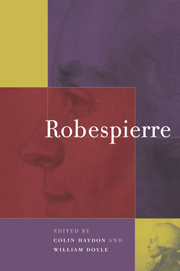Book contents
- Frontmatter
- Contents
- List of contributors
- Acknowledgements
- List of abbreviations
- Part I Introduction
- Part II Robespierre's outlook
- Part III Robespierre's politics
- Part IV Robespierre in retrospect
- 11 Carlyle's seagreen Robespierre and the perilous delights of picturesque history
- 12 Robespierre through the Chartist looking-glass
- 13 Rehabilitating Robespierre: Albert Mathiez and Georges Lefebvre as defenders of the Incorruptible
- 14 Robespierre in French fiction
- 15 The representation of Robespierre in European drama
- Part V Conclusion
- Index
11 - Carlyle's seagreen Robespierre and the perilous delights of picturesque history
Published online by Cambridge University Press: 14 January 2010
- Frontmatter
- Contents
- List of contributors
- Acknowledgements
- List of abbreviations
- Part I Introduction
- Part II Robespierre's outlook
- Part III Robespierre's politics
- Part IV Robespierre in retrospect
- 11 Carlyle's seagreen Robespierre and the perilous delights of picturesque history
- 12 Robespierre through the Chartist looking-glass
- 13 Rehabilitating Robespierre: Albert Mathiez and Georges Lefebvre as defenders of the Incorruptible
- 14 Robespierre in French fiction
- 15 The representation of Robespierre in European drama
- Part V Conclusion
- Index
Summary
When Thomas Carlyle's history of the French Revolution first appeared in 1837, reviewers applauded Carlyle's ability to bring history to life before his readers' eyes. John Stuart Mill, for instance, effusively praised his friend's graphic powers in the London and Westminster Review:
Mr Carlyle … brings us acquainted with persons, things, and events, before he suggests to us what to think of them: nay, we see that this is the very process by which he arrives at his own thoughts; he paints the thing to himself – he constructs a picture of it in his own mind, and does not, till afterwards, make any logical propositions about it at all. This done, his logical propositions concerning the thing may be true, or may be false; the thing is there, and any reader may find a totally different set of propositions in it if he can; as he might in the reality, if that had been before him.
While Mill's generous remarks suggest why the images of The French Revolution were so appealing to Carlyle's contemporary audience, they gloss over some of the problems arising from his visual techniques. Some of Carlyle's most compelling pictures are simply unfactual, as the historian Oscar Browning showed late in the nineteenth century. As he tricycled from Paris to Varennes, Browning came to the conclusion that many of the details in Carlyle's celebrated account of the flight to Varennes are ‘inexact’ and ‘some of them quite wrong and misleading’. ‘This is the danger of the picturesque school of historians,’ he complained. ‘They will be picturesque at any price.’
- Type
- Chapter
- Information
- Robespierre , pp. 177 - 193Publisher: Cambridge University PressPrint publication year: 1999



